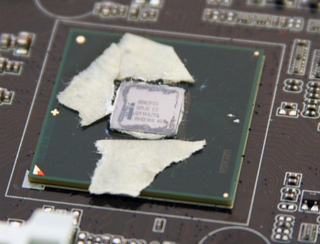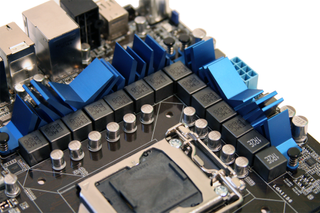Asus' P7P55D EVO Motherboard: Core i5 Finds A Home
The Board Arrives

The Core i5/P55 hardware has started rolling into our performance labs and we're getting our hands wet with it. Asus' first P55-based motherboard showed up earlier today, though, and we couldn't resist giving you an early preview of what the board will include when it hits store shelves on...
...Hello? Bestofmedia legal department? Oh, I can't say that? Bah, what a bunch of party poopers!
Well, I can promise you that we'll be seeing this hardware soon enough. In fact, we're close enough that if you've been in a holding pattern for your next mid-range platform, you might as well wait to see the real performance attributes of Core i5 and boards like this one: Asus' P7P55D Evo.
In the pages that follow, we'll take a trip around the platform to talk about the new LGA 1156 socket interface, a reversion to dual-channel memory, multi-graphics card support via PCI Express, and the possibility of 6 Gb/s SATA accompanying the upcoming launch.
The P55 PCH, Unveiled

In the preceding picture, you probably noticed that there's only one chipset component on the P7P55 Evo PCB. Of course, this is because much of the functionality previously housed by the memory controller hub (in the Core 2 days) now resides on the CPU package itself.
Core i7 saw the memory controller make its way into the processor, leaving Intel's X58 to handle PCI Express connectivity. Core i5 sees even that base function migrate northward into the processor, charging P55 with the capabilities once reserved for Intel's family of I/O Controller Hubs. In an effort to try differentiating, however, P55 is now being called a PCH, or Platform Controller Hub.
The PCH you see here is revision B1 silicon, which is still considered buggy. B2 will fix some of the board's existing USB compatibility issues, we hear.
Stay On the Cutting Edge: Get the Tom's Hardware Newsletter
Get Tom's Hardware's best news and in-depth reviews, straight to your inbox.
A New Socket Latch

If you've built a Core 2- or Core i7-based machine, then you know that the straight, rigid socket latch sometimes feels like it's putting tons of pressure on the CPU as you close it up. While I've never damaged a processor or motherboard with that mechanism, it did seem to secure itself unevenly.
The latch used to secure Asus' P7P55D Evo actually locks the processor into place from the back. The front of the socket closes by sliding under the stationary post vaguely recognizable in the picture above (and more clearly identifiable on the next page). Then as you drop the latch into the locking mechanism, the notched rear end of the lever rotates, nudging the top lid down, firmly seating the CPU.
LGA 1156, Wide Open

This is the socket itself, without the protective cap in place. For those who've installed any of Intel's LGA-based processors, this one isn't much different. The chip only fits one way. You lay it in gently and close up the socket lid over top.
What you will find new is the screw-like post, which keeps the front of the lid secure as the back end seats the processor itself. On the next page, we'll show the mechanism sliding into place.
Closing LGA 1156

The top of the socket lid sports these two little guides, which slide into place under the pictured post. This is indeed an elegant solution that doesn't seem to put as much pressure on an installed processor as you're locking it in.
Voltage Regulation And Its Cooling

Asus is using a 14-phase power solution here. The angular heatsinks may or may not make it onto the retail boards, according to the company. However, all of the other shots we've seen of the board (in addition to its Computex debut) show it with these same sinks, so there's a good chance they'll stay.
As you can see, there's plenty of room around the socket itself, though it was interesting to note that our Thermalright Ultra 120 Extreme barely sits on the LGA 1156 interface without touching the graphics card plugged in to the first PCI Express slot.
Back To Dual-Channel

Lynnfield (Core i5) and Bloomfield (Core i7) are different animals. While the latter supports triple-channel DDR3 memory configurations, the former loses one channel, bumping us back to the days of dual-channel configurations (officially at speeds of up to DDR3-1333, in the case of our setup here). Not that we're worried--Core i7 has more throughput than it can currently utilize, and we anticipate that this platform will similarly have plenty of memory bandwidth.
Specific to Asus' implementation are a couple of memory-oriented extras. The first is called MemOK!, which facilitates one-touch fail-safe presets whenever compatibility is a perceived issue. We don't have much information on what MemOK! does exactly (and we continued to have issues with one set of modules in particular), but we'll certainly dig deeper into the inner workings of this value-add when it comes time to review the retail hardware.
The second innovation is called Q-DIMM, though this one wasn't available on our pre-production engineering sample. But the concept is easy enough to imagine. You have two "clips" per DIMM slot, which lock the module in place with a snap. On the side closest to your graphics cards, the retail P7P55D Evo won't have the clips you see in our picture. Instead, the modules will slide into place and clip-in on the side closest to the board's edge. As a result, you won't need to yank your video card to swap/add modules. We've seen this issue avoided altogether by vendors shifting memory slots toward the edge a little more, freeing up room between DIMMs and the first PCI Express slot. However, this workaround does the trick, too.
Connectivity For Days

The P7P55D Evo's I/O panel reflects much of the connectivity enabled by Intel's P55 PCH and Asus' integrated extras.
PS/2 mouse/keyboard ports are standard fare, especially on mid-range platforms. Eight USB 2.0 ports reflect more than half of the P55 chipset's 14 total connectors (six are available via onboard headers, and there's no chipset-based USB 3.0 support quite yet). Coaxial and optical audio outputs are enabled through VIA's VT1828 eight-channel codec, along with a sextet of 1/8" mini-jack analog audio connectors. Dual Gigabit Ethernet connectivity is facilitated through Realtek's 8112L and 8110SC controllers, one a PCI Express component and the other, strangely, PCI-based. VIA's 6308P offers two FireWire 400 ports, one of which you see on the rear I/O panel and the other made available through an onboard header. The little button you see between the PS/2 and USB ports clears the BIOS--another common addition nowadays.
Slot Configuration

Asus gives the P7P55D Evo a fairly diverse slot configuration, including three PCI Express x16 slots, two PCI Express x1 slots, and a pair of PCI slots.
The way it all works is fairly simple: if you have a single graphics card plugged in to the first slot, you get a full 16 lanes of PCIe 2.0 connectivity from the Core i5's integrated link. With two cards connected, the processor's available lanes are divided between two x8 slots. The third x16 slot is electrically wired to run at x4 speeds and is attached to the P55 PCH (and thus wholly unsuited for a third graphics card, since P55 connects to Core i5 via the comparably-slow DMI). Similarly, the two x1 slots tie into P55, which includes eight available PCIe 2.0 lanes.
When you add up those six PCIe lanes, the PCIe Gigabit controller, and the onboard storage controller, it's no wonder Asus used a PCI controller for its second Ethernet chip.
Uup until now, we haven't heard much about the extent of multi-GPU support on Core i5. ATI's CrossFire is assumed, given Intel's support for the technology historically. However, we can also confirm that SLI will likely be included in the retail version of this board, too. We dropped in a pair of GeForce GTX 280s using Nvidia's 186.18 driver and had no problem enabling Nvidia's multi-card capability. This will very likely differ from vendor to vendor and board to board, depending on licensing. But just as most every X58 motherboard came to include SLI support, we hope P55 will be similar.
6 Gb/s SATA?

As of right now, Asus has Marvell's upcoming 88SE9123 two-port SATA 6 Gb/s controller onboard. However, the vendor isn't yet ready with its drivers, so the feature stands to get dropped if Marvell isn't able to deliver in time for Asus' launch. Not that this is a make-or-break feature--while 6 Gb/s SAS drives are already floating around, 6 Gb/s SATA drives are still missing in action.
PCIe Ethernet Controller

Here's the RTL8112L PCI Express-based Gigabit controller, which resides on the P55's last x1 link (forcing Asus to use a PCI controller for its second Gigabit connection).
-
burnley14 I'm still a little curious why Intel released 2 new sockets so close together. I'm sure there has to be a good reason why i5 was not released on 1366, since it certainly makes things less convenient.Reply -
cangelini burnley14I'm still a little curious why Intel released 2 new sockets so close together. I'm sure there has to be a good reason why i5 was not released on 1366, since it certainly makes things less convenient.Reply
Think of i7 as Xeon 5500-series and it makes a little more sense. That was Intel's high-performance breakout of what it was planning in the workstation/server market, really. -
anamaniac I love you Angelini.Reply
I want a i5 now. =D
The board is very clean looking. Hope they keep up the perfect professional look (such as the 15 phase power, which looks very sexy all neatly organized, and the colour scheme). -
doomtomb Thank you for this look over on the board. It appears as though the P55 boards have plenty of features but lack in the PCI-Express department which is rather disappointing for even people looking at two-way SLI or Crossfire (like myself).Reply -
dmv915 falchardWhere is the southbridge?Reply
That basically is the south bridge that you see. P55 is a single chip motherboard. Most if not all of the north bridge has been moved onto the cpu. -
Losing one memory channel isn't too bad, benchmarks show Nehalem gets enough bandwidth from dual channel. But it's disappointing to think that most P55 boards will have only 4 dimms. I was waiting for i5 to build a workstation running SQL Server and wanted to put at least 12 GB of RAM inside (2GB DDR3 sticks are a lot cheaper than 4GB sticks).Reply
-
cimtaurus doomtombThank you for this look over on the board. It appears as though the P55 boards have plenty of features but lack in the PCI-Express department which is rather disappointing for even people looking at two-way SLI or Crossfire (like myself).This was exactly my reasoning for NOT waiting for the i5 and instead building an i7 machine.Reply
When the new 40nm cards come out I want to put triple SLI into my rig, and i5 just wouldn't handle that well.
Still, for a mid range machine this looks promising. If/when they develop some micro boards for the i5 I can see it making a nice HTPC.
Most Popular







